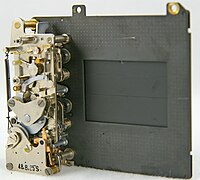
Photo from wikipedia
Abstract Theoretical and numerical analysis of the plane wave diffraction by a fractional axicon with less than one degree is performed in the near-field considering the evanescent waves. The first… Click to show full abstract
Abstract Theoretical and numerical analysis of the plane wave diffraction by a fractional axicon with less than one degree is performed in the near-field considering the evanescent waves. The first type of Rayleigh-Sommerfeld integral transformation is used in the calculations. It is shown that the stationary phase method application is not sufficiently precise to obtain analytical estimates in the near-field diffraction. Additional corrections have been introduced to clarify the solution. They have provided qualitative agreement of theoretical and numerical results. It is shown that by using a fractional axicon, which degree is significantly less than one, in the area of the evanescent waves the light spot with both longitudinal and transverse sizes of one tenth of wavelength is formed.
Journal Title: Optics Communications
Year Published: 2017
Link to full text (if available)
Share on Social Media: Sign Up to like & get
recommendations!